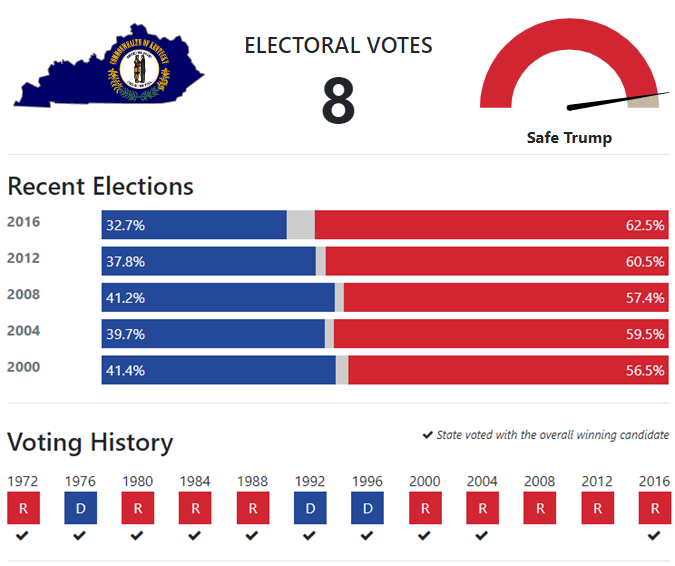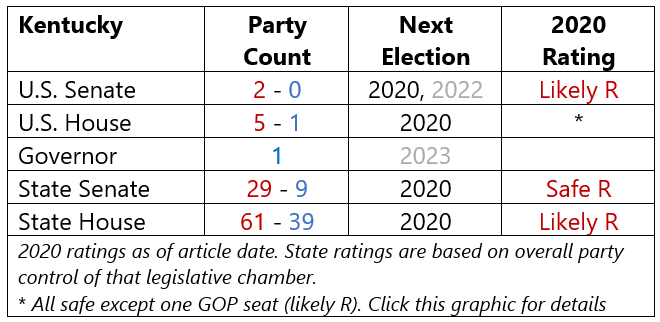The Road to 270: Kentucky
By Seth Moskowitz
February 17, 2020
The Road to 270 is a weekly column leading up to the presidential election. Each installment is dedicated to understanding one state’s political landscape and how that might influence which party will win its electoral votes in 2020. We’ll do these roughly in order of expected competitiveness, moving toward the most intensely contested battlegrounds as election day nears.
The Road to 270 will be published every Monday. The column is written by Seth Moskowitz, a 270toWin elections and politics contributor. Contact Seth at s.k.moskowitz@gmail.com or on Twitter @skmoskowitz.
Kentucky
Kentucky is all but certain to vote for Donald Trump in November. It has voted Republican at the presidential level - with few exceptions - since 1956. The president carried the state by 30% in 2016, continuing a fairly consistent trend of increasing GOP margins in each election since 2000.
Given this inevitability, the second half of this piece is dedicated to the boogeyman of the left, Mitch McConnell. Democrats revile the cunning effectiveness of the Senate Majority Leader and hope, perhaps naively, to oust him in November.
First though, let’s look at Kentucky’s political legacy and how it evolved into the deep red state it is today.
Statehood and Civil War
Until 1792, the region we know as Kentucky was a part of Virginia. The Appalachian Mountains isolated western Virginians, who started to push for an independent state. In 1790, the Virginia legislature approved the new state and two years later Congress accepted it. The new state was framed by its geography, with the Ohio River to its north, Mississippi River on its western tip, and the Cumberland Mountains in its east.
For most of its first elections, Kentucky voted along with the rest of the south for Thomas Jefferson’s Democratic-Republican Party. The party broadly advocated for a less powerful federal government and supported the agrarian lifestyle of the south. Once the Democratic-Republican Party fractured, Kentucky shifted to the Whig Party that was founded by Henry Clay, at that time a U.S. Senator from the state.
In 1860, Kentucky cast its electoral votes for the Constitutional Union Party, which was a single-issue party focused on keeping the Union together. The state had economic ties to both the Confederate South and Union North and was physically located in the middle of the conflict — bordered by Tennessee and Virginia to the south and Ohio, Indiana, and Illinois to the north. Kentucky decided not to secede and initially claimed neutrality in the war. This stance ended in 1861 when the Confederate army invaded Kentucky in order to take control of tactical land before the Union army could. From then on, Kentucky sided with the Union.
Post-War Democratic Dominance
Kentucky, like most of the south, was steadily Democratic following the Civil War. The western region of the state was historically slave-holding territory and therefore voted for the Democratic Party. Meanwhile, the population in the state’s east had supported the Union and would reliably vote Republican. Through most of the 19th Century, however, these Republican regions were not enough to make the state competitive. Democrats regularly won the state by double digits.
The 1896 election broke the streak. That year, Democrats nominated the bimetallist and populist, William Jennings Bryan. The Republican standard bearer, William McKinley, eked out a 0.07% popular vote victory over Bryan, making him the first Republican presidential nominee to ever carry Kentucky. The state would flip back to its Democratic roots for the next six elections, but by smaller margins than before. In five of the six elections from 1900 to 1920, the Democratic nominee would win by less than 6%. In the 1920s lead-up to the Great Depression, Kentucky voted for two Republicans in 1924 and 1928. These were the Roaring Twenties and Kentucky, along with most of the nation, rewarded the incumbent Republican Party for the strong economy.
Then came the Great Depression. Kentucky voted for Franklin Roosevelt and the New Deal which employed thousands of people in Kentucky and helped prop up and revive the coal, bourbon, and tobacco industries in Kentucky.
A Shift Rightward
The popularity of the New Deal and Roosevelt would help Democrats win Kentucky through the 1952 election. Eventually, though, the Democratic Party’s leftward shift on social issues would push Kentucky progressively deeper into the Republican Party. In 1956, President Dwight Eisenhower won reelection and carried Kentucky in a landslide election over his Democratic opponent, Adlai Stevenson. Since that 1956 Republican victory, Democrats have only carried the state four times.
All of these victors were southerners. First is Lyndon Johnson who carried Kentucky in his 1964 landslide. Second is Georgian Jimmy Carter who won Kentucky in his initial election of 1976 but lost it to Ronald Reagan in 1980. The last Democrat to win Kentucky was Bill Clinton of Arkansas in his 1992 and 1996 elections.
Bill Clinton was also the last Democratic presidential nominee to be competitive in Kentucky. Four years later, Democrats nominated Al Gore, whose signature issue was environmental protection. This did not play well in Kentucky’s coal country and, along with the Democratic Party’s liberal shift on social issues including abortion and gun control, helped push the state decisively towards George Bush.
Recent Elections & Political Landscape
Starting in 2000, every Republican nominee would carry Kentucky by double digits. George Bush did so by 15% and 20% in 2000 and 2004. John McCain beat Barack Obama by 16% in the state even as Obama won nationally by 7%. In 2012 Mitt Romney won the state by 23%. And finally, in 2016, Donald Trump expanded that margin to 30%, the largest margin of victory since 1868.
In 1996, Bill Clinton carried counties across the state. He won majorities in the mountainous east, the ancestrally Democratic west, and in the urban regions. Support for Democrats steadily eroded in most of these counties and every four years since, the Democratic nominee carried fewer counties than their predecessor.
While external forces are more to blame for the coal industry's decline, Barack Obama’s strict regulations on coal production did little to ingratiate his party to Kentuckians. In 2016, Hillary Clinton’s infamous “we're going to put a lot of coal miners and coal companies out of business” quote1 1That often-quoted comment didn't capture the full context of what she actually said. did even more damage.
As jobs in the coal and manufacturing industry evaporated, Kentucky struggled to replace them. While the urban and suburban communities inside the Golden Triangle of Lexington, Louisville, and Cincinnati have thriving auto, equestrian, logistics, and bourbon industries, the rest of the state is in worse shape. Outside of this economically humming region, Kentuckians are facing lower incomes, higher poverty rates, shrinking populations, and drug addictions.
In 2016, Hillary Clinton won just two counties, Jefferson and Fayette, that encompass the state’s biggest cities of Louisville and Lexington and are far more diverse than the state overall. Meanwhile, Donald Trump, expanded on Romney’s margin in nearly the entire state. He improved most in the state’s northeastern rural Appalachia. His populist calls to “Make America Great Again” were most effective with this struggling, shrinking, and disaffected population.
Demographics make the recent rightward shift unsurprising. 68% of the state's population are whites that do not have a college degree. This is a core constituency of today's GOP. Only neighboring West Virginia has a higher proportion (75%) of residents in this category.
Republican Mastermind and Democratic Nemesis: Mitch McConnell
While Kentucky’s presidential contest in November is all but decided, Senate Majority Leader and Democratic boogeyman, Mitch McConnell, is up for reelection and Democrats are drooling at the idea of ousting him.
The Kentucky primary in the state is not until May, but both nominees are all but decided. Republicans are destined to re-nominate McConnell. Democrats are on track to nominate former Marine fighter pilot Amy McGrath. In 2018, McGrath made a high-profile congressional bid in Kentucky’s Sixth District against incumbent Rep. Andy Barr. It is a district much more receptive to Democrats than the state as a whole, but McGrath lost by 3%.
Democrats look at Kentucky’s 2019 gubernatorial election and hope that 2020 could be a repeat. Last year, Democrat Andy Beshear beat Republican Matt Bevin in Kentucky’s off-year gubernatorial election. However, Bevin was a historically weak candidate who alienated voters at every turn.
McGrath boosters also point to McConnell’s extreme unpopularity as an indicator of his vulnerability. McConnell has had no problem carrying the state in the past even with low favorability ratings haunting him for much of his career. While his first two elections in 1984 and 1990 were real competitions — he won by just 0.4% and 4.4% — after that he was entrenched. His next four victories would be by 13%, 29%, 6%, and 17%. Even in 2008, a heavily blue year where Barack Obama won the national popular vote by over 7%, McConnell still won his election by 6%.
These victories were back when Kentucky was bluer, partisanship was weaker, and split ticket voting was more common. Voters today are less likely than ever to break with their party identity and Kentucky is more Republican than ever. With Trump at the top of the ticket, likely carrying the state by another 30% margin, Democrats would need an electoral miracle to oust McConnell. And with a candidate as vetted and battle-tested as he is, there is unlikely to be any surprising or unknown revelations that could damage his candidacy as to make him vulnerable.
The Cook Political Report has the election rated as Likely Republican. The newsletter’s Senate and Governors Editor, Jessica Taylor, explained to us why she is bullish on McConnell’s reelection prospects.
“Given the sheer amount of money that Amy McGrath has been raising means this is a race to keep an eye on, but Democrats have been aiming to take down McConnell for years and have failed, and the Senate Majority Leader is heavily favored once again.
McConnell is a shrewd politician who will do anything to win, especially when it comes to his own seat. The Kentucky governor's race may have flipped, but that was even close with an incredibly unpopular Republican, and voters look differently at federal versus state races. McGrath got off to a rocky start too when she rolled out her campaign, and many House Democrats were not happy with the race she ran in 2018 which should have been winnable in a very good year for Democrats. The environment won't be as favorable for Democrats again in a presidential year with Trump expected to carry Kentucky handily.
If we are talking about this being a toss up race in the fall, Democrats will definitely be taking back the Senate and winning the presidency. But that's really hard to imagine such a scenario.”
Last week, the Democratic Senatorial Campaign Committee — the campaign wing of the Senate Democrats — endorsed McGrath. But as Taylor points out, McGrath would likely need an extremely favorable national environment to oust McConnell. Her impressive fundraising numbers might help her get her message out, but in the deep red Bluegrass State, that message is unlikely to resonate with enough voters to propel her to victory.
Next Week: Massachusetts



